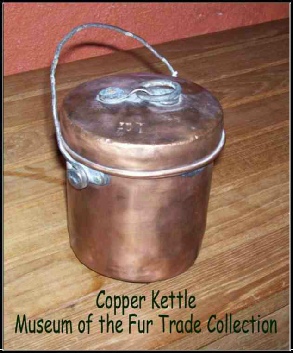Subject Guide

Mountain West
Malachite’s Big Hole
Cooking Implements:
Although Mountain Man cooking was usually as simple as roasting a slab of buffalo meat over a fire, cooking utensils made it possible to cook a much greater variety of meals. And of course, hot water for coffee or tea was much simpler in a pot or kettle. The Indians also appreciated metal pots and pans for ease of use over their traditional methods for cooking stews and soups. Prices shown are St. Louis costs and quantities are typical of those taken to rendezvous.
|
No. |
Units |
Item Description |
Cost |
|
6 |
nests |
Sheet Iron Kettles |
28¢/? |
|
4 |
|
Sheet Iron Kettles |
|
|
6 |
|
Brass Kettles |
|
|
2 |
nests |
Tin Kettles 14 in a nest |
|
|
4 |
nests |
Tin Kettles |
|
|
3 |
nests |
Tin Kettles |
$2.25/? |
|
3 |
dozen |
Tin Cups |
56¢/? |
|
4 |
dozen |
Assorted Tin Pans |
$2.50/? |
|
½ |
dozen |
Pewter Tumblers |
|
|
1 |
dozen |
Spoons |
|
|
13 |
|
Soup Plates |
|
|
1 |
|
Iron Ladle |
|
|
1 |
|
Four Quart Tea Kettle |
|
|
23 |
|
Small Tin Pans |
8.25¢/? |
|
4 |
|
Oval Tin Pans |
|
 Most kettles, pots and pans were sheet metal. Copper kettles appear to have been
largely phased out in the western trade by the late 1820’s and replaced by tin or
sheet iron kettles. The only referral I’ve seen to copper kettles is that on William
Ashley’s 1826 contract to supply Smith, Jackson and Sublette in the mountains (reference
Morgan). Tin kettles are simply sheet iron kettles that have been coated in tin.
The tin prevents rusting of the kettle.
Most kettles, pots and pans were sheet metal. Copper kettles appear to have been
largely phased out in the western trade by the late 1820’s and replaced by tin or
sheet iron kettles. The only referral I’ve seen to copper kettles is that on William
Ashley’s 1826 contract to supply Smith, Jackson and Sublette in the mountains (reference
Morgan). Tin kettles are simply sheet iron kettles that have been coated in tin.
The tin prevents rusting of the kettle.
Cast iron fry pans, pots and kettles did exist at this time, but the weight of these implements made it impractical for men who were essentially on a year long packing trip.